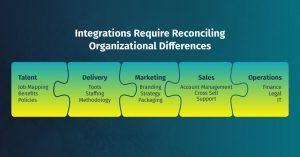M&A Integration: Making The Marriage Thrive
You’ve pulled it off! You’ve successfully completed an M&A deal. After hundreds of hours devising an M&A strategy, evaluating targets, and completing due diligence, you can’t wait to start capitalizing on all those goals and synergies you laid out in the original business case.
Phew. Now is when the real work begins. It’s time to make the marriage work.
If you thought finding and evaluating a target was difficult, just wait for what happens when you try to get two organizations to collaborate harmoniously and profitably.
As an operations executive, I have led or been part of half a dozen technology services acquisitions. I’ve been on integration teams at both large consulting firms ($5B+) and regional firms ($50M-$100M), worked with public companies and private companies, and on both the buy and the sell side. So I’ve experienced personally both the highs and lows of M&A integration.
In this blog, I’ll share some of the lessons learned from those experiences, and dive into where and how to effectively and thoughtfully integrate an acquisition. Bear in mind that each integration is different, which means there is no standard playbook. My takeaways are by no means comprehensive or absolute, but they will give you a starting place.
The Big Picture: M&A Integration Principles
Here are three truisms I’ve observed over the decades.
1. Protect what you pay for
Your integration plan should align with your acquisition goals. Acquisitions (and therefore integrations) generally fall into one of three categories:
- Absorption: This focuses on economies of scale. Here an acquirer would typically merge revenue-generating talent into their existing organization and eliminate duplicative functions.
- Symbiosis: This focuses on expanding capabilities often in a complimentary space. Here an acquired firm might maintain more independence but still integrate certain aspects.
- Preservation: This focuses on growth and expansion into new areas. Here an acquired firm may remain independent so the acquirer can collect revenues or learn without disruption.
All too often, leaders pursue integration in ways that undermine the acquisition. They instinctively jump in to start cutting costs to capitalize on synergies, or immediately start integrating systems and processes, as if there’s a standard playbook. But there needs to be an artful and customized process so make sure your actions support the strategic justification for the deal.
For example, if you’ve purchased a nimble, fast-growing startup because it offers more speed and responsiveness than your large, established firm, shackling the nimble firm with big-firm bureaucracy and outdated systems could destroy its DNA and alienate top talent.
2. Change is inevitable. Don’t try to hide it
Most people find change challenging, especially when it’s foisted upon them. You may be tempted to reassure teams by saying, “nothing is going to change.” This is a mistake. Things will inevitably change. When they do, you will be left explaining why you were wrong, which will make you look either naive or disingenuous. Neither is good. It’s better to be candid. Instead, tell your team, “Some things are going to change. You should be aware of that.” Then be patient and forthright and help them get through it.
3. Clarity and collaboration promote loyalty
During M&A, employees often have the feeling of something being done to them, and that feeling of helplessness can cause people to disengage. To the extent you can, try to give people a voice in the process. Be clear about the purpose and value of the combined entities, and then foster collaboration between groups to bring people along and give them a sense of ownership.
One of the most important things you can do is to set clear targets for leaders so they have a north star and know exactly what they need to accomplish. If leaders are bought into their targets, they will be far more likely to dedicate themselves to achieving them.
Integrations require reconciling organizational differences
Now that you have a set of guiding principals, let’s dive into specifics around integration planning and execution.
Integration planning is about identifying and reconciling the differences between your two firms – figuring out which to align and which to leave alone. Acquisitions will generally affect every function in the acquired firm in some way. Some more than others. A simple philosophy that I’ve used and recommend is “Integrate Where It Matters”. You shouldn’t necessarily integrate all functions and processes at once as people will get overwhelmed. Instead, identify a staggered approach to integrate when it matters while still driving a “one team” approach.
HR: Job Mapping, Benefits, Policies
HR plays a pivotal and delicate role in helping people make the transition to the new entity. Chances are the acquiree’s talent represents a significant portion of the value you purchased, so you want to handle these areas delicately.
Job role mapping and leveling: You will likely need to address compensation discrepancies between two firms that may have different compensation philosophies and career pathing. This can be particularly stark if the two firms are not in the same business or operate in different markets. Communication and compromise are key. For instance, if salaries or titles are lower for incoming employees, speak to how new skills, scope or resource availability might justify a different pay scale. Be honest and authentic. Sometimes employees simply need to accept a new normal.
Benefits: In most cases, it won’t make financial sense to retain the acquiree’s benefits, however, be aware that the transition to a new package can be inconvenient, disappointing, or even disorienting for people who rely on them. Even if the benefits are better. For instance, even if the healthcare plan is more generous, individuals or their families may need to change their primary-care physician. Empathy and assistance in helping employees adjust to changes can help build goodwill. Create a side-by-side comparison of the old versus new benefits to help employees understand exactly what they’re getting—both the positive and negative. For example, the burden of finding a new healthcare provider, for instance, may be offset by a better 401k match.
Policies: Policies set the ground rules for employees, and when the ground rules change, it can be disorienting. Vacation and sick leave policies will likely need to be rationalized. If the organizations are in different industries or at different stages of maturity, that can be challenging. For example, startups might attract employees through unlimited vacation policies while larger firms might have standard tenured based vacation policies. Expense policies and technology policies should also be rationalized. Consultants tend to travel a lot, so if you are making dramatic changes here, think through how you will communicate and enforce these.
HR plays a pivotal and delicate role in helping people make the transition to the new entity. Communication and compromise are key.
Delivery: Tools, Staffing, Methodology
Aligning how delivery teams work together and with customers is complex and takes careful planning. There are many factors to consider here, so involving leaders and representatives from both the acquiree and acquirer in the integration planning process will ensure you understand the impact and value of considered changes. It will also help you make the best decisions for both customer quality and employee engagement.
Tools and technology: Delivery teams will rely on many different systems and tools to do their jobs, from the Professional Services Automation (PSA) systems used to staff projects and log time, to the collaboration and development tools they use day-to-day. In most cases, you will want to consolidate into a single PSA but may have more leeway for individual tools.
Staffing and teaming: This area takes more change management than you might expect, so allow the right time and resources for this and prepare for it to be done in phases. How quickly you address differences depends upon how quickly the two teams will be co-delivering projects. In general, the initial focus should be on new projects and accounts, in particular those where acquiree and acquirer individuals will collectively work together as a team.
Methodology and governance: Most firms of any scale will have a specified way they train delivery staff, deliver work (often across different teams), and manage customers. Ultimately these may need to be rationalized. This requires reworking documents, training programs, systems and processes, and lots of change management.
Involving leaders and representatives from both the acquiree and acquirer in the integration planning process will ensure you understand the impact and value of considered changes.
Marketing: Branding, Strategy, Packaging
How you integrate marketing teams and strategies should reflect your initial goal for the acquisition. For example, if the plan is to fully absorb the acquired firm
into an existing one, you will make very different branding and packaging decisions than you would if you’re preserving and running two firms separately.
Branding: Brand is one of the first questions you will need to address. Does the acquired company keep its name? If so, for how long? Is it fully standalone or a sub-brand of the acquiring company (e.g. Arroyo Strategy, a Jabil Company)? This is a big decision and sometimes there are unintended consequences, so don’t be afraid to bring in different perspectives and advisors to help you think through the branding strategy.
Go-to-market strategy: Figuring out how you will jointly go-to-market with customers, work with partners and communicate with stakeholders (press, analysts, investors, etc.) is key to capitalizing on market synergies. Once the strategy is determined, it can help inform future organization and team structures, demand generation plans and budgets.
Packaging and pricing: As two organizations start thinking through what they will offer customers and how to package and price it, it’s important to have a shared understanding of market dynamics, the customer profiles you’re servicing and what exists today. Do the two organizations have competing products? If so, rationalizing to one product can alleviate confusion for customers and tension in the team. In contrast, complimentary products can continue to standalone. If you’re rationalizing pricing, it can help to do a “Willingness to Pay” analysis.
The way you integrate marketing teams and strategies should reflect your initial goal for the acquisition.
Sales: Account Management, Cross Sell, Customer Support
Integrating sales teams can help accelerate an acquisition’s revenue objectives, but like all things, it needs to be done thoughtfully. Understanding the current state of both sales organizations – the people, processes, tools and culture across those teams – is an important first step. Only then can you map out future state.
Account Management: The two organizations will need to map where they have customers in common. This involves determining who will own the relationship, and in the case of shared customers, how you will manage primary and secondary interactions. To prevent confusion, you will need to discuss the changes with customers.
Cross sell: This is frequently a big goal of an acquisition, but leaders can underestimate how difficult it is and how long it takes to cultivate. Sales reps are naturally protective of their relationships, and a getting-to-know-you process has to occur before cross-selling is possible. Leaders need to train sales reps to understand each other’s services. Trust needs to be built. After a few successful deals, cross-selling naturally gains momentum, but this could take up to a year. Potentially less if the two organizations’ offerings are similar.
Customer success: How you support and grow customers over time, is also something that needs to be determined. Some firms have a project based mentality, moving from one customer to the next. Others are built almost entirely on growing existing accounts. There may also be disparities between customer profiles. In some cases, a smaller acquired firm may have certain clients that don’t fit the target or margin profile of a larger acquired firm. How you handle these clients needs to be discussed with both organizations.
Integrating sales teams is an important step in accelerating an acquisition’s revenue objectives, but like all things, it needs to be done thoughtfully.
Operations: Finance, Legal, IT
“Back office” functions like finance, legal and IT are often one of the first areas that are rationalized after an acquisition. However, integrating systems and processes in these areas can be more complex than many companies expect and keeping people motivated here can be tricky. These teams may fear, often rightly, that their jobs are in jeopardy. The need to secure future employment may distract them from the difficult task at hand. The best way to deal with this is to be open and honest, and incentivize them to collaborate. If their fears are justified, consider negotiating severance or a bonus to be paid upon timely completion of the integration.
Finance: It can be tempting to maintain separate books after an acquisition, at least during the transition. Companies have different accounting processes, calendars, cultures and reporting needs and bringing them together can be overwhelming. However, I’ve found the best approach is to integrate as promptly as possible—generally within the first three to six months. In most strategies, having a single reporting system is inevitable in the long run and having a single system boosts efficiency, consistency and accuracy (if done right). It also reduces costs and redundancy, and provides better visibility into the combined company’s performance.
The alternative—keeping separate books—requires more work because you need to reconcile them monthly, and is prone to errors. Merging systems may not be realistic for highly acquisitive or more complex organizations. In those cases, a Corporate Performance Management solution that collects data from disparate data sources and generates consolidated financial results can work wonders.
Legal: Adjusting to an acquirer’s legal function and processes can also be challenging, and isn’t typically thought about until it creates friction. Smaller firms may not have rigorous contract review processes or attorneys on staff. Suddenly, a process that had been quick and straightforward for the smaller firm, such as getting a contract signed or approving a hire, may be slow and demanding. Again, compromise and communication are key. If a more streamlined contract process is not possible, the sales team and clients will need to be informed, to manage their expectations.
IT: Tools and systems can be one of the major pain points during integration. Different preferred tech stacks tend to drive a lot of dissatisfaction when done without proper change management. My recommendation would be to stagger the tools and systems changes to reduce the level of anxiety when it makes sense. Some changes are non-negotiable (e.g. PSA, ERP or financial systems) but some could be slow rolled vs. driving everything together to “get it done”.
Integrating systems and processes in these areas can be more complex than many companies expect, and keeping people motivated here can be tricky.
Communicate, Communicate and Communicate Again
Leaders often underappreciate the breadth and importance of communications. A well-executed communications strategy can’t guarantee the success of a merger, but a poorly conceived or executed one can sow the seeds of failure.
An effective communications plan starts well before the deal’s announcement, touches virtually every aspect of the business, and continues well beyond the first few months of an acquisition. I could write an entire blog on this topic but since this blog is long enough I’ll leave you with three pieces of advice:
Be open: You won’t always have an answer, and it’s fine to admit that and say you’ll find out. Transparency builds clarity and confidence, forestalling rumors and gossip.
Be prepared: Leaders should expect their role as communicators to consume a significant amount of time, particularly in the early months when the two organizations are trying to learn one another’s business.
Be inclusive: Bringing more leaders into the discussions during the integration process can facilitate collaboration and a shared sense of ownership for its success.
The Bottom Line
Acquisitions are pivotal events for any organization. In many cases the change is abrupt and monumental. There’s a distinct before and after. In other cases it’s more gradual. No matter how big or small the transaction or company being acquired is, don’t underestimate the effort and intention it takes for an acquisition to be successful. Plan ahead, and expect the unexpected.
Read our insights featured in Tercera.
About Darshan Deshmukh
Darshan Deshmukh is the President of Arroyo Strategy. He has extensive global operations and delivery experience in the managed services and advisory fields. He has deep expertise in building global programs focused on procurement, strategic sourcing, category management, and supply chain/procurement transformation.Prior to joining Arroyo Strategy, Darshan spent most of his career building large-scale, global delivery operations. He spent a decade in a series of global leadership positions in IBM’s Integrated Supply Chain organization and then joined Denali Sourcing Services as operations leader and was instrumental in establishing and growing the company’s global delivery capability. After Denali’s acquisition integration with WNS, Darshan transitioned to tech start-ups, OpenGov and Icertis, where he built their global professional services and customer success organizations. Darshan has worked with global clients in high-tech, financial services, manufacturing, retail, utilities, and healthcare/pharma.
About Arroyo Strategy
Arroyo Strategy, a Jabil company, is the leading provider of procurement services, offering advisory, managed services, digital, staffing, and recruiting solutions. For more than 25 years, we have focused exclusively on helping clients elevate their procurement function.
We combine leading methodologies, analytics, market intelligence, and industry benchmarks with our uniquely flexible and customizable service delivery model. Global organizations of all sizes trust Arroyo Strategy to transform their procurement operations, drive growth, and reimagine what’s possible.
Let Arroyo Strategy help you reimagine your procurement capabilities.
Media contact:
Kathleen M. Pomento
Chief Marketing Officer | Arroyo Strategy
kpomento@arroyostrategy.com






